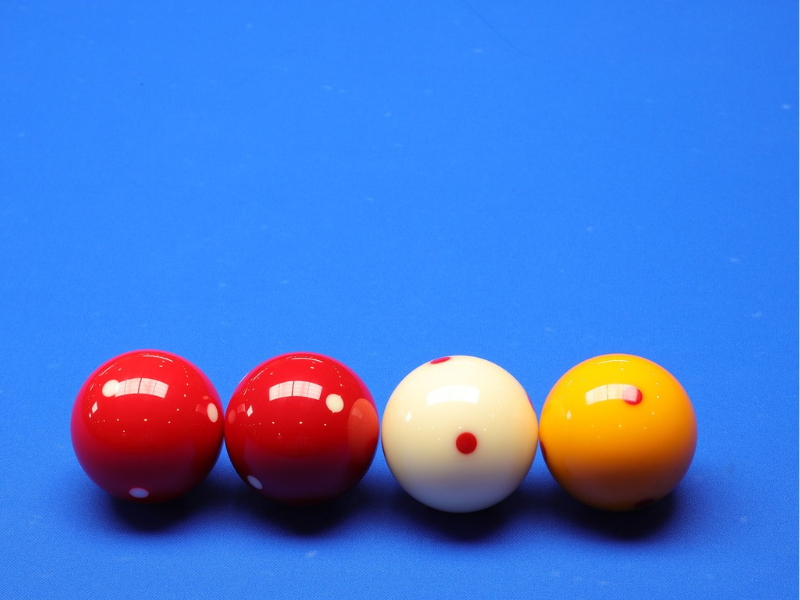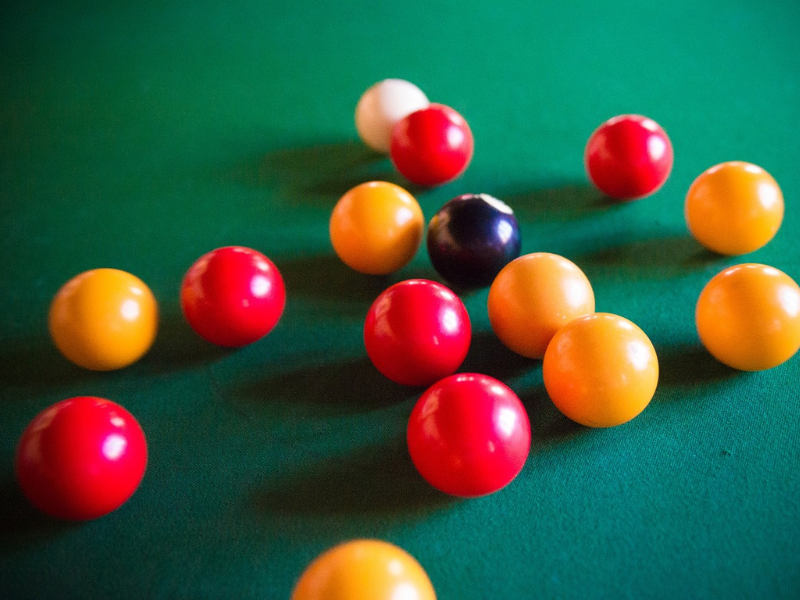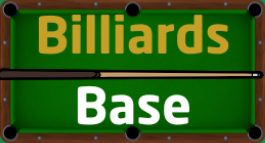English pool stands as one of the most beloved cue sports across the UK and many Commonwealth countries, offering a unique blend of strategy, skill, and accessibility that sets it apart from its American counterpart. English pool rules, on the other hand, can feel overwhelming and irritating to understand at first.
Whether you’re stepping into a local pub for your first game or looking to compete in organized tournaments, understanding the official rules is essential for fair play and enjoyment.
What is English Pool?

English pool, often simply called “pool” in the UK, is played on smaller tables than American pool, typically measuring 7 feet in length compared to the 9-foot tables common in the United States. The game uses 15 colored balls plus a white cue ball, with seven red balls, seven yellow balls, and one black ball (the “8-ball” equivalent).
The fundamental objective remains similar to American 8-ball: players must pot all balls of their designated color group before legally potting the black ball to win the frame. However, the smaller table, different ball sizes, and distinct rule variations create a unique playing experience that emphasizes precision and tactical thinking.
Main Rule Sets
Three primary rule sets govern English pool:
- World Eightball Pool Federation (WEPF) “World Rules” – The most widely adopted international standard
- Blackball Rules – Popular in many European countries and some UK venues
- Local UK variations – Traditional pub rules that may vary by region
| Feature | English Pool | American Pool |
| Table Size | 7ft × 3.5ft | 9ft × 4.5ft |
| Ball Size | 2 inches | 2.25 inches |
| Colored Groups | Reds & Yellows | Stripes & Solids |
| Pockets | Smaller, tighter | Larger, more forgiving |
Official English Pool Rule Sets

The evolution of English pool rules reflects the sport’s journey from casual pub games to organized international competition. The World Eightball Pool Federation (WEPF), established in the 1990s, created the “World Rules” to standardize play across different countries and venues.
World Rules emphasize skill-based play with specific requirements for shot-making and ball nomination. Under these rules, players must clearly nominate their intended ball and pocket for each shot, promoting tactical play and reducing luck-based outcomes.
Blackball Rules, governed by organizations like Blackball International, offer slight variations in foul penalties and gameplay mechanics. These rules are particularly popular in European tournaments and some UK regional competitions.
The key distinction between rule sets often centers on the “two-visit” rule (explained below) and specific foul penalties, making it essential to establish which rules apply before beginning play.
Equipment & Table Setup
Not all equipment and tables are equal in billiards. Even if you’re very new to the game, you won’t be spared the laughter of everyone else in the hall if you try to bring snooker equipment to pool or vice versa.
Making sure you pick the right pool balls, are using the correct table for English pool versus American pool, and the correct cue – all of these things are important to consider on top of the actual ruleset.
Required Equipment
- Table: 7ft × 3.5ft English pool table with six pockets
- Balls: Set of 15 colored balls (7 red, 7 yellow, 1 black) plus white cue ball
- Triangle: For racking the colored balls
- Cues: Appropriate length for the smaller table, and the best English pool cues
- Chalk: For cue tip maintenance
Ball Arrangement
The 15 colored balls are arranged in a triangle with:
- Black ball positioned in the center of the triangle
- One red and one yellow ball at the back corners
- Remaining balls arranged randomly within the triangle
- Triangle positioned so the front ball sits on the foot spot
Table Features
The English pool table includes a “D” area at the head of the table—a semi-circular area where the cue ball must be placed for the break and after certain fouls.
Starting the Game: The Break
Determining the Break
The first break is typically decided by:
- Coin toss
- Lag shot (both players shoot simultaneously from the D to the far cushion)
- Tournament seeding or predetermined order
Legal Break Requirements
To execute a legal break, the player must:
- Position the cue ball anywhere within the D area
- Strike the triangle of balls with sufficient force
- Achieve one of the following:
- Pot at least one colored ball, OR
- Drive at least two colored balls plus the cue ball to a cushion
Break Violations
An illegal break occurs when:
- No balls are potted AND fewer than two colored balls hit a cushion
- The cue ball is potted (“scratched”)
- Balls leave the table
- The triangle is not struck first
Penalty: The incoming player may either re-rack for a new break or play the table as it lies, with the cue ball placed in the D.
Rules of Play: Step by Step
Declaring Groups (Reds/Yellows)
English pool begins with an “open table” period immediately following the break. During this phase:
- No groups are assigned to either player
- Players may legally target any colored ball (red or yellow)
- Assignment occurs when a player pots their first colored ball
- The player who pots the first colored ball claims that color group
- Combination shots are permitted during the open table period
Example: If Player A pots a red ball during the open table phase, they become the “reds” player and must pot all red balls before attempting the black ball.
Potting Balls and Taking Shots
Once groups are established, players must follow specific shot requirements:
Ball Nomination
Under World Rules:
- Nominate your target ball before each shot
- Nominate the intended pocket for the target ball
- Obvious shots may not require verbal nomination
- Combination shots must be clearly nominated
Legal Shot Requirements
Every shot must satisfy these conditions:
- Hit your group ball first (after groups are established)
- Drive a ball to a cushion OR pot a ball
- Maintain cue ball on table throughout the shot
Continued Play
A player continues shooting when they:
- Legally pot one of their group balls
- Are awarded additional shots due to opponent’s foul
Fouls and Penalties
English pool rules employ a “two-visit” penalty system for most fouls, meaning the incoming player receives two consecutive shots.
Common Fouls Include:
Ball-Related Fouls:
- Potting the cue ball
- Failing to hit your group ball first
- Potting an opponent’s ball
- Causing balls to leave the table
Shot-Related Fouls:
- Failing to drive any ball to a cushion when no ball is potted
- Double-hitting the cue ball
- Touching balls with hand, cue, or clothing
- Having both feet off the floor during a shot
Conduct Fouls:
- Unsporting behavior
- Coaching violations during play
- Slow play warnings
Foul Penalties
Standard Penalty: Two visits (consecutive shots) awarded to opponent
Ball-in-Hand: After certain fouls, the incoming player may place the cue ball anywhere in the D area
The Eight Ball (Black Ball)
The black ball represents the game-winning opportunity but comes with strict requirements:
Legal Black Ball Shots
- Clear your group first: All of your colored balls must be potted before attempting the black
- Nominate pocket: Clearly indicate which pocket you’re targeting
- Clean contact: Hit the black ball first without fouling
Automatic Loss Situations
You lose the frame immediately if you:
- Pot the black ball before clearing your group
- Pot the black ball and cue ball simultaneously
- Pot the black ball in an un-nominated pocket
- Commit any foul while shooting at the black ball
- Cause the black ball to leave the table
Winning, Draws & Tie-Breaks
Winning a Frame
A player wins by:
- Legally potting the black ball after clearing their color group
- Opponent commits a loss-of-frame foul involving the black ball
- Opponent concedes the frame
Drawn Games
Rare situations may result in a draw:
- Stalemate positions where no legal shot is possible
- Equipment failure affecting play
- Agreed draw between players in casual play
Tournament Tie-Breaks
In organized play, tie-breaks typically involve:
- Re-racking for a deciding frame
- Sudden-death formats
- Modified scoring systems as determined by tournament rules
Differences Between World Rules, Blackball, and Local Rules

Understanding rule variations helps ensure smooth play across different venues and competitions:
| Aspect | World Rules (WEPF) | Blackball Rules | Traditional UK Pub Rules |
| Shot Nomination | Required for all shots | Required for unclear shots | Often not required |
| Two-Visit Rule | Standard penalty | Standard penalty | May vary by venue |
| Jump Shots | Illegal | Illegal | Generally illegal |
| Skill Shots | Defined requirements | Defined requirements | Informal guidelines |
| Foul Penalties | Standardized system | Slight variations | Variable by location |
Key Distinction: The “Skill Shot”
Both World Rules and Blackball Rules define minimum skill requirements for legal shots, preventing players from simply rolling the cue ball into their group without attempting to pot or achieve position.
The top English pool tournaments vary slightly on rules; if you need to make a comprehensive rule clarification, consult the WEPF Official Rules or Blackball International.
Pool Table Etiquette & Good Practice
Respectful Play Guidelines
During Your Opponent’s Shot:
- Remain seated and quiet
- Avoid moving within their line of sight
- Keep personal items away from the table area
- Refrain from practicing strokes or cleaning cue tips
General Conduct:
- Shake hands before and after matches
- Acknowledge good shots from opponents
- Accept referee decisions gracefully
- Maintain equipment properly
Dispute Resolution:
- Discuss rule questions calmly and respectfully
- Consult rule books when uncertain
- Accept neutral third-party arbitration
- Focus on sportsmanship over winning
Equipment Care
- Return balls gently to the table after cleaning
- Use chalk moderately to avoid excessive residue
- Handle cues carefully to prevent warping or damage
- Report equipment issues to venue management promptly
Frequently Asked Questions (FAQs)
What’s the difference between English pool and American pool?
There are tons of differences between English and American Pool, but here’s a TL;DR: English pool uses smaller tables (7ft vs 9ft), smaller balls (2″ vs 2.25″), and features red/yellow colored groups instead of stripes and solids. The rules also emphasize nomination shots and include the two-visit penalty system.
What is an open table?
An open table occurs at the start of each frame, before players have established their color groups. During this period, either player may target any colored ball, and groups are assigned based on the first ball potted.
Are jump shots legal in English pool?
No, jump shots are illegal under both World Rules and Blackball Rules. Players must keep the cue ball in contact with the table surface throughout their shot.
What happens if I pot the black ball early?
Potting the black ball before clearing all balls in your color group results in an immediate loss of frame, regardless of whether any other fouls occurred during the shot.
Do I lose if I commit a foul on the black ball?
Yes, any foul committed while shooting at the black ball (after legally being able to shoot at it) results in loss of frame in English pool rules, including common fouls like potting the cue ball or failing to hit the black ball first.
Can I play a safety shot in English pool?
Yes, safety play is legal and strategic. However, you must still fulfill the basic shot requirements: hit your group ball first and either pot a ball or drive any ball to a cushion after contact.
Playing English Pool Correctly
Understanding English pool rules enhances both your playing experience and respect for this beloved cue sport. Whether you’re playing under World Rules, Blackball regulations, or local variations, the fundamental principles remain consistent: skill, sportsmanship, and strategic thinking define quality play.
The key to improvement lies in regular practice combined with proper rule knowledge. Start by mastering basic shot requirements and foul avoidance, then gradually develop advanced tactical skills like safety play and position control.
Remember that rules exist to ensure fair, enjoyable competition for all participants. When in doubt, consult official sources, ask experienced players, or refer to qualified referees who can provide authoritative guidance.
Next Steps
- Practice fundamental shots on properly maintained equipment
- Study official rule books for your preferred rule set
- Join local leagues or clubs to gain competitive experience
- Develop tactical understanding through observation and instruction
This article provides general guidance on English pool rules. Always verify current regulations with official governing bodies for tournament or competitive play.
